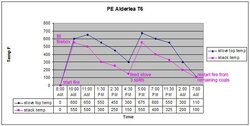I think I might be running my new PE Summit too hot, but I'm not sure. I've never used a new EPA stove before and I'm a bit confused. I can get a decent fire going, maybe half a load or a bit less on top of the coals. I keep the air high until the flue temp hits 400-500 and the wood chars nicely. Then I start cutting back the air and the problems begin... The stovetop temperature starts rising and, even with the air all the way down, will hit 800+. At the same time the flue temp drops down. I'm worried about really loading the stove since there seems to be no way to slow it down once it takes off. I could cut the are back earlier, but then I'd be concerned about creosote (I've always run a hot flue, 400-500 doesn't even seem hot enough to me).
Anyway any advice is greatly appreciated
Chris
Anyway any advice is greatly appreciated
Chris



